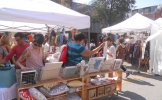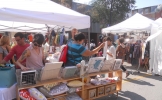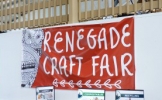Selling your work at a good craft fair is awesome – all you have to do is show up, and someone else does all the work to bring the shoppers to you. But before you can sell to these willing customers, your craft show application has to win you a spot in that fair. No worries if you're a first-timer, though. Just check out the craft show application information and tips below to apply for shows successfully.
Types of Craft Fairs
The broadest categories that craft fairs can be split into are juried and non-juried:
- Juried fairs hand-select participants. Think: art fairs, big-name DIY craft events like the Renegade Craft Fair.
- Non-juried fairs generally fill tables on a first-come, first-serve basis. Think: community craft events.
Two Things to Know Before Applying for a Craft Fair

How To Build an Artist Website
Sign up for our newsletter and get the book How to Build an Artist Website for free!
- You will need to pay a table fee, and you'll need to pay it up front when you apply for shows. Depending on the event, this can range from $10 to hundreds of dollars. Juried craft fairs often require a separate application fee as well.
- You might need to provide your own equipment. Most fairs include tables and chairs, but some require you to bring or rent a canopy, for example.
Filling Out Your Craft Show Application
This piece will focus on applying for juried craft fairs, because, well, how much advice do you need for filling out a form for a first-come, first-serve event? (Actually, if you do need advice, here it is: Get your application in early – even if an event is non-juried, it will still have a limited number of tables.)
A craft show application usually requires some combination of the following:
- Photos. A clear, well-lit visual representation of your work is important. When you apply for shows, take photographs of your work in natural light, with a clean, simple background. And don't crop photos too close – make sure that the judges can get a good feel for the piece as a whole.
- Description of Work. Keep in mind that festivals sometimes use your description not just for their own information, but to promote your work on their websites. Market your work without hyperbole. No one is going to believe you if you say, “These are the most gorgeous necklaces in Texas!!” And when you're done writing, make sure to proofread your description.
- Website. If you don't have a website, consider building one; it increases your legitimacy.
One important thing to remember when filling out a craft show application is that you don't just want to look awesome, you also want to be accurate. The judges for juried fairs don't just want to find good work – they want to find work that is good for their event. And you want this too – if you make futuristic brushed-steel jewelry, it doesn't make much sense to sell your work at a folk-art fair.
So go forth and apply for shows, hopeful crafter. And if you don't make it into a festival, remember – you can always try again next year.




